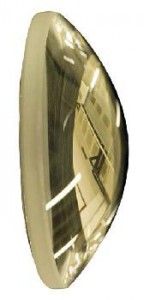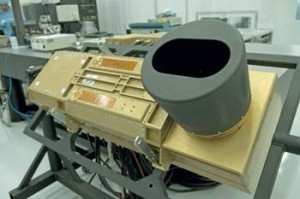 eduardo cesarIntegrated into the Chinese-Brazilian land resources satellite, at an altitude of 800 km, a camera entirely developed and manufactured in Brazil by Opto Eletronica, from the city of São Carlos, inner-state São Paulo, is to record deforestation and urban expansion, as well as crop and livestock farming in Brazil and abroad, among other uses, starting in 2011, when the Cbers-3 satellite is scheduled for launch. On July 21, the camera’s second version was delivered to Inpe, Brazil’s National Space Research Institute, to be sent to China, where it is to undergo tests, the so-called qualification trial. The first version, that was ready in December 2007 and was shipped to China in June 2008, had to be entirely redesigned after the United States and other countries restricted the importing of several of the components used in it. This final obstacle turned into an opportunity for the development of national technology to make the parts used. For this reason, the new version was dubbed MUX Free.
eduardo cesarIntegrated into the Chinese-Brazilian land resources satellite, at an altitude of 800 km, a camera entirely developed and manufactured in Brazil by Opto Eletronica, from the city of São Carlos, inner-state São Paulo, is to record deforestation and urban expansion, as well as crop and livestock farming in Brazil and abroad, among other uses, starting in 2011, when the Cbers-3 satellite is scheduled for launch. On July 21, the camera’s second version was delivered to Inpe, Brazil’s National Space Research Institute, to be sent to China, where it is to undergo tests, the so-called qualification trial. The first version, that was ready in December 2007 and was shipped to China in June 2008, had to be entirely redesigned after the United States and other countries restricted the importing of several of the components used in it. This final obstacle turned into an opportunity for the development of national technology to make the parts used. For this reason, the new version was dubbed MUX Free.
“The camera is the first of its kind and purpose to be entirely designed and made in Brazil,” says engineer Mário Stefani, Opto’s R&D director and coordinator of the multispectral camera project. The device records images in four colors – blue, green, red and infrared – in well defined narrow bands. The previous camera, made by China and attached to Cbers-2, which is currently in orbit, worked with only three colors (the above minus blue). “The combination of the four spectral bands enables one to see the quality of river water, whether the soil is exposed or degraded, and whether vegetation is degraded, or areas occupied irregularly. The blue is useful mainly to assess water resources,” says Stefani. The Brazilian camera has 4 lines of 6 thousand pixels; each pixel covers a 20-meter area on the ground. The width of the strip pictured, the extension of the territory seen on one line of the image, is 120 km.
The process of making a camera capable of withstanding the rocket launcher, operating in outer space at zero gravity, in a vacuum and under a constant bombardment of radiation, comprises several stages. “We made two engineering models and one more qualification model is to be made, to be followed by the three flight models.” However, before beginning to develop the project, the firm had to win an international tender bid held by Inpe in December 2004. The camera’s preliminary project was presented in October 2005 and, in December 2007, the first engineering model was delivered. This had to be totally redone following the boycott. The new engineering model delivered to Inpe is to undergo several trials, for its functionality and its capacity to withstand the space environment to be confirmed. Only after this stage will the qualification model made, to be followed by the actual flight models, expected to be ready in July 2010. These will form part of the payload of the Cbers-3 and Cbers-4 satellites, the latter scheduled for launch in 2014.

eduardo cesarMUX Free camera covers an area of 20 meters on the groundeduardo cesar
Opto is also a member of the consortium for the development of a second camera that is to be part of the Chinese-Brazilian satellites numbers 3 and 4. This camera is a WFI (for wide field imager) and is being developed in partnership with the firm Equatorial Sistemas, from the city of São José dos Campos, in inner-state São Paulo. In this project, Opto is responsible for the optical and electronic part, while Equatorial is in charge of the processing and video signal, as well as for thermal control. The WFI camera has a wider coverage angle, but a lower resolution than the MUX. “The WFI is to be delivered in October for the qualification trials,” says Stefani. Besides the two cameras made by these Brazilian enterprises, the satellites will carry another two, made by the Chinese. “All in all, we will deliver three sets of MUX plus WFI cameras for flying, totaling six cameras,” says Stefani. Of these sets, one is for Cbers-3, one is for Cbers -4, and the third is the replacement set, should any problems arise. Stefani heads a team of 56 professionals who are working simultaneously on the development of three cameras: two for the Chinese-Brazilian satellites and the third one for the Amazonia-1 satellite. The latter is an AWFI (advanced wide field imager), with a spatial resolution of 40 meters and imaging capacity covering a 780 km strip of land.
Ever since Opto was established back in 1985 by professors Milton Ferreira de Souza and Jarbas Caiado de Castro, the firm and its affiliates have been granted aid by FAPESP’s Pipe Program (Innovative Research in Small Firms), which financed, in particular, studies in the fields of industrial applications and ophthalmic equipment for medical use. The first aid grant, that dates back to 1988, was for the development of a laser measuring device for long distances, for industrial use, under Stefani’s coordination. The product was ready two years later but it never took off commercially. Only eight of these devices were ever sold: seven to Vale do Rio Doce (mining company) and one to Firestone. “Despite this commercial failure, the project helped the company to develop both its human and its instrumental capabilities, giving rise to technological knowhow that resulted in the development of a highly competitive laser device for retina surgery,” says Stefani. The company still makes this laser device – a major commercial success that has assured the company a strong position in the international market – with the same people and equipment used in the first FAPESP-financed project. At present, Opto, which is active in the fields of ophthalmological medical equipment, anti-reflection treatments for lenses, measurement, control and defense instruments, and aerospace products, has 450 employees, 58 of whom are researchers. Its R&D investment is, on average, equal to about 15% of its sales, which last year amounted to R$50 million.
Once the cameras are up in space, Opto will help Brazil to join the limited group of countries that make orbital imaging systems, currently comprising the United States, Russia, France, Israel, India and China. Its participation in the MUX project plus the Pipe projects has enabled the firm to acquire cutting-edge infrastructure, with a secure room and machines for space trials. As a result, Opto was able to develop a second generation of retina scanners, devices that map the retina and that are on a par with those made by international giants. “The space program worked as a powerful indication of the country’s industrial capabilities, helping it to become competitive in important fields,” says Stefani.
Republish
